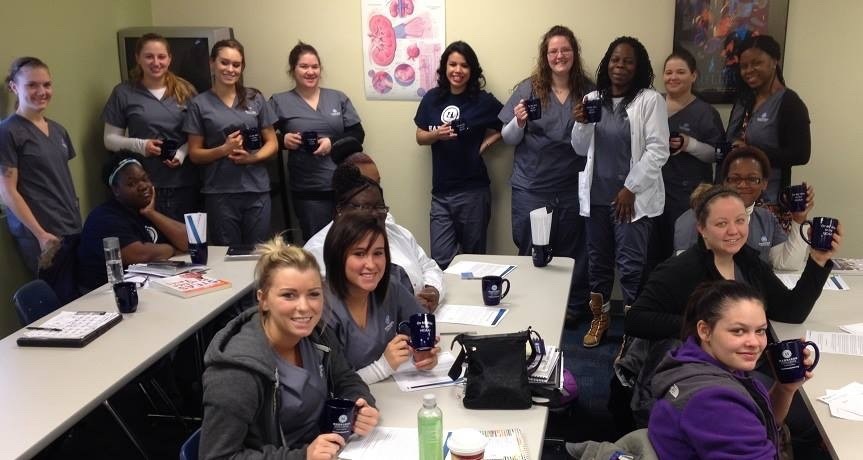Wondering what the average labor and delivery nurse salary is? Want to know what their typical job responsibilities include? Then we’ve got you covered!
Whether you’re a prospective nursing student or an experienced nurse looking to make a change, labor and delivery is a popular nursing specialty.
Labor and delivery nurses get to witness childbirth, save lives, and care for both new babies and new mothers (often all in one shift!).
Considering that over 3.5 million babies are born in hospitals across the United States each year, labor and delivery nurses are in high demand and will be for the foreseeable future.
Table of contents
- What Does a Labor and Delivery Nurse Do?
- Where Do Labor and Delivery Nurses Work?
- How to Become a Labor and Delivery Nurse
- Can a New Nurse Go Straight into Working in Labor and Delivery?
- Benefits of Working as a Labor and Delivery Nurse
- Drawbacks of Working as a Labor and Delivery Nurse
- Demand and Job Outlook for Labor and Delivery Nurses
- Work Schedules for Labor and Delivery Nurses
- Labor and Delivery Nurse Salary Statistics
- Labor and Delivery Nurse Average Salary by Years of Experience
- States with the Highest Labor and Delivery Nurse Average Salary
- States with the Lowest Labor and Delivery Nurse Average Salary
- Cities with the Highest Labor and Delivery Nurse Average Salary
- Cities with the Lowest Labor and Delivery Nurse Average Salary
- Conclusion
What Does a Labor and Delivery Nurse Do?
Labor and delivery nurses may have duties throughout the unit. However, what they do will depend on their assignment. It also depends on how the hospital and unit choose to assign staff.
Some hospitals prefer a one-to-one nursing care model. In this model, nurses remain with their patient throughout the stages of labor and delivery.
Other hospitals will have different nurses assigned to each stage. The patient will be assigned to different nurses as they move through the labor and delivery process.
When a patient comes to the unit, nurses in the triage room will determine the next course of action. More specifically, they determine:
- Who the patient needs to see in the healthcare team
- Whether the patient will proceed to a delivery room or follow a different course of action
In the delivery room, nurses work together with the team of care providers to ensure a safe delivery for mother and baby.
Some of this work may include:
- Offering emotional support to laboring mothers and partners
- Advocating for birth plans as much as possible
- Relaying information about labor progress to others like OBGYNs or midwives
If the patient requires a cesarian section, then labor and delivery nurses prepare the patient to go into surgery.
After delivery, nurses monitor both mother and baby and provide necessary care to both. They usually assist the patients in transferring to a recovery room. Once there, they will continue to be monitored until discharge.
In addition to direct patient care, labor and delivery nurses also teach new parents about things like newborn care, health, and safety.
They also communicate all status updates to other people involved in patient care. This includes:
- OBGYNs
- Pediatricians
- Lactation consultants
- Nursing aides.
Specific Labor and Delivery Nursing Duties
If you want to become a labor and delivery nurse, you’ll likely perform some of the following tasks:
- Taking vital signs and performing assessments on mother and baby
- Preparing, running, and maintaining IVs
- Monitoring contractions
- Coaching patients through delivery
- Assisting with cesarian sections or other surgical procedures
- Providing perineum care or surgical wound care
- Executing emergency procedures
Where Do Labor and Delivery Nurses Work?
Most labor and delivery nurses are employed at hospitals, so many hospitals have designated labor and delivery units. This is where all patient care related to labor and delivery occurs.
Nurses here are typically specialized in their department, so they only work within the labor and delivery unit.
These nurses often have a variety of roles, meaning they can work in:
- Triage rooms
- Delivery rooms
- Recovery rooms
- Operating rooms
Less often, labor and delivery nurses may find employment outside of hospitals at places like birthing centers. They may even work with midwives assisting home births.
Regardless of location, the job is the same. They care for mothers and babies during the labor, delivery, and immediate postpartum stages.
How to Become a Labor and Delivery Nurse
Anyone with the goal of becoming a labor and delivery nurse will have to go through a similar process. To become one, you must:
- Acquire a degree
- Become a licensed and registered nurse
- Gain either experience, additional certification, or advanced nursing degrees.
We discuss these three steps in more detail below:
1. Complete the Necessary Schooling
Labor and delivery nurses first get academic nursing degrees. Then they can become registered nurses.
Some people become labor and delivery nurses with an associates degree (AND). However, these days, most will complete a bachelor’s degree in nursing (BSN) at an accredited institution.
Nursing degree education includes both standard coursework and clinical rotations.
2. Pass the NCLEX
After earning a nursing degree, nurses don’t get the “RN” credential until they’ve passed the NCLEX.
This is a national nursing exam. It ensures that nurses are educated thoroughly enough to enter the workforce.
3. Start Working and Gain Experience
Labor and delivery is a nursing specialty. Typically, new nurses will gain experience in more generalized departments like emergency or med/surg first.
Doing this helps nurses see and treat a variety of conditions under real-world circumstances. This allows them to get comfortable with nursing in general.
They’ll also develop nursing skills, like documentation and time management, before pursuing a specialty department.
Can a New Nurse Go Straight into Working in Labor and Delivery?
Some nurses do end up in labor and delivery departments right out of school. However, it sometimes requires luck and finding the right opening at the right time.
In other cases, there are steps you can take to have a better chance at securing a labor and delivery nursing position. This is possible even without much (or any) previous nursing experience.
Acquire Additional Certification
For labor and delivery nurses, Inpatient Obstetric Nursing certification (RNC-OB) is offered through the National Certification Corporation.
This certification shows that a nurse is skilled and knowledgeable about labor and delivery:
- Conditions
- Complications
- Procedures
Pursue an Advanced Nursing Degree
Instead of entering the workforce right after becoming a registered nurse, some nurses choose to return to an educational program at the master’s or doctorate level. This allows them to become a nurse practitioner (NP) or advanced practice registered nurse (APRN) in obstetrics and gynecology.
Others may choose to become certified nurse-midwives (CNMs).
After completion of these programs, nurses are ready to begin working in their specialty.
Benefits of Working as a Labor and Delivery Nurse
There are lots of benefits to working as a labor and delivery nurse. Some include:
- Getting to witness childbirth daily
- Spending time with newborn babies
- Being a major part of what many people consider the best day of their lives
Drawbacks of Working as a Labor and Delivery Nurse
Unfortunately, there are also a few drawbacsk to working as a labor and delivery nurse. They include:
- Working only with laboring mothers and newborns, and not gaining experience with other patients or conditions
- Navigating emotions with their patients, as childbirth is often an emotional and high-stress event for patients and families
- Coping with bad outcomes, though relatively infrequent compared to good ones, may be particularly hard since they involve new mothers and newborns
Demand and Job Outlook for Labor and Delivery Nurses
Demand for labor and delivery nurses will depend entirely on how many babies are being born. In the United States, the birth rate is currently declining.
There is certainly still a need for labor and delivery nurses, but lower birth rates means that fewer nurses are needed. This also means there will be more competition for labor and delivery nursing positions.
Work Schedules for Labor and Delivery Nurses
Since labor and delivery nurses mostly work in hospitals, they are needed 24 hours a day.
Round-the-clock nursing staff is typically scheduled in either 8-hour or 12-hour shifts. The exact times of these shifts will vary from hospital to hospital.
Labor and delivery nurses work full-time, part-time, or even per diem. Some employers may allow nurses to work overtime hours, while some have strict policies against it.
Labor and Delivery Nurse Salary Statistics
The average national for labor and delivery nurse salaries across all levels of experience is $32.29 per hour, or about $67,000 per year.
However, salary will depend on factors like:
- Experience
- Location
- Particular employer
Labor and Delivery Nurse Average Salary by Years of Experience
| Years of Experience | Hourly Average | Annual Average |
| 0-1 years (Entry-Level) | $21.56 | $43,120 |
| 1-4 Years | $24.88 | $49,780 |
| 5-9 Years | $30.40 | $60,800 |
| 10-19 Years | $37.77 | $75,560 |
| 20+ Years | $46.91 | $93,840 |
States with the Highest Labor and Delivery Nurse Average Salary
| State | Annual Salary | |
| 1 | California | $101,210 |
| 2 | Hawaii | $88,010 |
| 3 | Massachusetts | $80,800 |
| 4 | Oregon | $80,790 |
| 5 | Alaska | $79,980 |
States with the Lowest Labor and Delivery Nurse Average Salary
| State | Annual Salary | |
| 1 | Alabama | $50,560 |
| 2 | South Dakota | $51,180 |
| 3 | Mississippi | $51,420 |
| 4 | Iowa | $52,530 |
| 5 | Arkansas | $53,430 |
Cities with the Highest Labor and Delivery Nurse Average Salary
| City | Salary | |
| 1 | Oakland, CA | $125,260 |
| 2 | San Francisco, CA | $125,260 |
| 3 | San Jose, CA | $123,300 |
| 4 | Sacramento, CA | $112,790 |
| 5 | Modesto, CA | $101,660 |
Cities with the Lowest Labor and Delivery Nurse Average Salary
| City | Annual Salary | |
| 1 | Huntsville, AL | $49,200 |
| 2 | Wichita, KS | $49,930 |
| 3 | Fort Wayne, IN | $52,510 |
| 4 | Des Moines, IA | $53,850 |
| 5 | Lexington, KY | $53,990 |
Conclusion
Labor and delivery nursing is an average-paying career among nursing specialties. It can bring in a well-above or well-below average salary, depending on location and experience.
These specialized nurses care for mothers and babies during the labor, delivery, and newly postpartum period.
Becoming a labor and delivery nurse requires at the very least an associates degree in nursing. It also requires successful passing of the NCLEX.
Pursuing a career in labor and delivery nursing may become more competitive if birth rates continue to decline. However, it’s a worthwhile career path if you’re passionate about caring for mothers and babies.
To become a labor and delivery nurse, enroll in a nursing degree program now!

Nurse Luke is a CRNA who specializes in Nursing content and still enjoys a very busy career with Locum, Per Diem and Travel nursing in the greater midwest. He has over 25 years of experience in the healthcare field and received his CRNA masters degree from the Mayo Clinic School of Healthcare. He is passionate about helping nurses explore the options of becoming a travel nurse as well as spending time with his Family.



